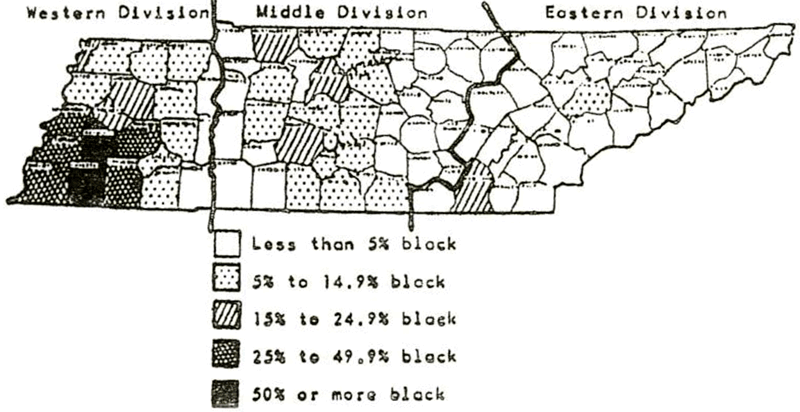Tennessee's Black Population
[Minorities in Tennessee continued]
Historically, total population growth in Tennessee has increased at an accelerating rate in every decennial census since 1950, and it seems to be continuing to increase. The state's population growth rate was only 8.4 percent in the 1950s but rose slightly to 10.1 percent in the 1960s before climbing to 16.9 percent in 1970. The growth rate for the 1980s was somewhat lower at 10.4 percent. The 2010 Census count showed that Tennessee had a total population of 6,346,105, its highest population ever. This figure represents a growth of 656,822 people or 11.5 percent from the 2000 population of 5,689,283. Tennessee's growth rate during the relevant 10-year period was almost 20 percent higher than the comparable national growth rate of 9.7 percent. Only 18 of the 50 states experienced a larger percentage increase than did Tennessee. Tennessee ranked 17th among the states in total population size in 2010 and 16th in 2000 (Moser and Johns, 2011). The pattern of growth rates among Tennessee's black population contrasts sharply with that of the state as a whole, showing large peaks and valleys over the past 60 years.
This recent increase in the rate of growth in the black population has important implications for the population mix in Tennessee. In 2000, blacks represented 16.4 percent of the state's population. In 2010, the proportion of blacks was 16.7 percent of the state's population. This figure represent a 0.3 percent increase and is the smallest increase since 1980, when the state had a .01 percent decline from 1970 to 1980.
Distribution by Region and Counties
While the proportion of blacks in the population continues to grow, blacks are not evenly distributed among the regions and counties of Tennessee. Traditionally, Tennessee is divided into three grand divisions, western, middle, and eastern. Of these, the Western Division contains a far greater percentage of blacks. The concentration of blacks in this segment of the state reflects Tennessee's border with Mississippi, where the area most heavily populated by blacks is in the southwest quadrant of the state (Hollman and Waller, 1981:3).
